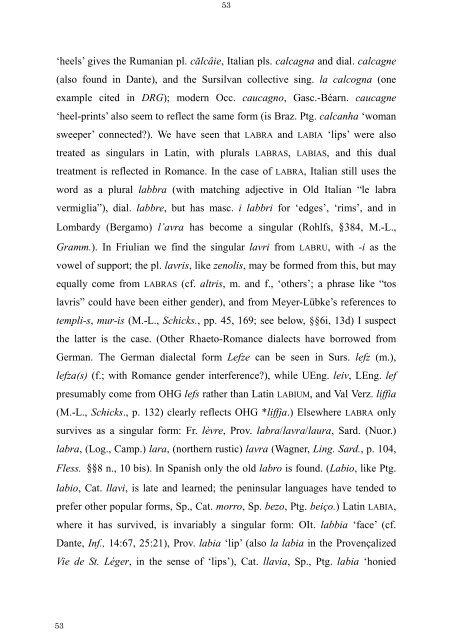The Latin Neuter Plurals in Romance - Page ON
The Latin Neuter Plurals in Romance - Page ON
The Latin Neuter Plurals in Romance - Page ON
Create successful ePaper yourself
Turn your PDF publications into a flip-book with our unique Google optimized e-Paper software.
53<br />
53<br />
‘heels’ gives the Rumanian pl. călcâie, Italian pls. calcagna and dial. calcagne<br />
(also found <strong>in</strong> Dante), and the Sursilvan collective s<strong>in</strong>g. la calcogna (one<br />
example cited <strong>in</strong> DRG); modern Occ. caucagno, Gasc.-Béarn. caucagne<br />
‘heel-pr<strong>in</strong>ts’ also seem to reflect the same form (is Braz. Ptg. calcanha ‘woman<br />
sweeper’ connected?). We have seen that LABRA and LABIA ‘lips’ were also<br />
treated as s<strong>in</strong>gulars <strong>in</strong> <strong>Lat<strong>in</strong></strong>, with plurals LABRAS, LABIAS, and this dual<br />
treatment is reflected <strong>in</strong> <strong>Romance</strong>. In the case of LABRA, Italian still uses the<br />
word as a plural labbra (with match<strong>in</strong>g adjective <strong>in</strong> Old Italian “le labra<br />
vermiglia”), dial. labbre, but has masc. i labbri for ‘edges’, ‘rims’, and <strong>in</strong><br />
Lombardy (Bergamo) l’avra has become a s<strong>in</strong>gular (Rohlfs, §384, M.-L.,<br />
Gramm.). In Friulian we f<strong>in</strong>d the s<strong>in</strong>gular lavri from LABRU, with -i as the<br />
vowel of support; the pl. lavris, like zenolis, may be formed from this, but may<br />
equally come from LABRAS (cf. altris, m. and f., ‘others’; a phrase like “tos<br />
lavris” could have been either gender), and from Meyer-Lübke’s references to<br />
templi-s, mur-is (M.-L., Schicks., pp. 45, 169; see below, §§6i, 13d) I suspect<br />
the latter is the case. (Other Rhaeto-<strong>Romance</strong> dialects have borrowed from<br />
German. <strong>The</strong> German dialectal form Lefze can be seen <strong>in</strong> Surs. lefz (m.),<br />
lefza(s) (f.; with <strong>Romance</strong> gender <strong>in</strong>terference?), while UEng. leiv, LEng. lef<br />
presumably come from OHG lefs rather than <strong>Lat<strong>in</strong></strong> LABIUM, and Val Verz. liffia<br />
(M.-L., Schicks., p. 132) clearly reflects OHG *liffja.) Elsewhere LABRA only<br />
survives as a s<strong>in</strong>gular form: Fr. lèvre, Prov. labra/lavra/laura, Sard. (Nuor.)<br />
labra, (Log., Camp.) lara, (northern rustic) lavra (Wagner, L<strong>in</strong>g. Sard., p. 104,<br />
Fless. §§8 n., 10 bis). In Spanish only the old labro is found. (Labio, like Ptg.<br />
labio, Cat. llavi, is late and learned; the pen<strong>in</strong>sular languages have tended to<br />
prefer other popular forms, Sp., Cat. morro, Sp. bezo, Ptg. beiço.) <strong>Lat<strong>in</strong></strong> LABIA,<br />
where it has survived, is <strong>in</strong>variably a s<strong>in</strong>gular form: OIt. labbia ‘face’ (cf.<br />
Dante, Inf., 14:67, 25:21), Prov. labia ‘lip’ (also la labia <strong>in</strong> the Provençalized<br />
Vie de St. Léger, <strong>in</strong> the sense of ‘lips’), Cat. llavia, Sp., Ptg. labia ‘honied









